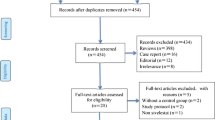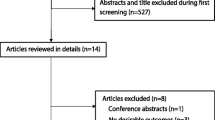Abstract
Background
To confirm the effectiveness of sivelestat, a clinical trial was conducted comparing sivelestat with conventional treatment in an open, nonrandomized, multicenter study of patients with systemic inflammatory response syndrome (SIRS)–associated acute lung injury. The primary endpoint was ventilator-free days (VFD).
Methods
This study adopted a “cluster entry” method to control for patient selection bias arising from the unblinded and nonrandomized clinical trial. Thus, all patients in the same hospital during the same entry period entered the same treatment arm, and entry periods did not overlap. In the primary analysis of VFD, adjusted mean VFD values were compared between groups using the inverse probability of treatment weighted (IPTW) method, based on propensity score, for control of confounding factors.
Results
There were 374 patients in the sivelestat group and 168 in the conventional therapy group. The primary analysis confirmed that sivelestat was effective (between-group difference of adjusted mean was 3.5 [2-sided 95% confidence interval, 1.3-5.8]; P =.0022).
Conclusions
In general, a study where all patients in the same cluster enter the same treatment arm has within-cluster correlations, which need to be considered in the study analysis. However, in analysis using the IPTW method, it is usual to use a robust variance estimator, the sandwich variance estimator, which is consistent regardless of whether the specification of within-cluster correlation structure is correct. Thus, in the analysis using the IPTW method, it was found that it was not necessary to adopt any other adjustment method for within-cluster correlation.
Similar content being viewed by others
References
Bernard GR, Artigas A, Brigham KL, et al. The American-European Consensus Conference on ARDS. Definitions, mechanisms, relevant outcomes, and clinical trial coordination. Am J Respir Crit Care Med. 1994;149:818–824.
Members of the American College of Chest Physicians/Society of Critical Care Medicine Consensus Conference Committee American College of Chest Physicians/Society of Critical Care Medicine Consensus Conference: definitions for 15/20 sepsis and organ failure and guidelines for the use of innovative therapies in sepsis. Crit Care Med. 1992; 20:864–874.
Kodama T, Yukioka H, Kato T, Kato N, Hato F, Kitagawa S. Neutrophil elastase as a predicting factor for development of acute lung injury. Intern Med. 2007;46:699–704.
Kawabata K, Suzuki M, Sugitani M, Imaki K, Toda M, Miyamoto T. ONO-5046, a novel inhibitor of human neutrophil elastase. Biochem Biophys Res Commun.1991;177:814–820.
Aikawa N, Ishizaka A, Hirasawa H, et al. Reevaluation of the efficacy and safety of the neutrophil elastase inhibitor, Sivelestat for the treatment of acute lung injury associated with systemic inflammatory response syndrome; a phase IV study. Pulm Pharmacol Ther. 2011;24:549–554.
Rosenbaum PR, Rubin DB. The central role of the propensity score in observational studies for causal effects. Biometrika. 1983;70:41–55.
D’Agostino RB, Jr. Propensity score methods for bias reduction in the comparison of a treatment to a non-randomized control group. Stat Med. 1998;17:2265–2281.
Kurth T, Walker AM, Glynn RJ, et al. Results of multivariable logistic regression, propensity matching, propensity adjustment, and propensity-based weighting under conditions of nonuniform effect. Am J Epidemiol. 2006;163:262–270.
Austin PC, Grootendorst P, Normand SL, Anderson GM. Conditioning on the propensity score can result in biased estimation of common measures of treatment effect: a Monte Carlo study. Stat Med. 2007;26:754–768.
Rubin D. The design versus the analysis of observational studies for causal effects: parallels with the design of randomized trials. Stat Med. 2007;26:20–36.
Schoenfeld DA, Bernard GR. ARDS Network: Statistical evaluation of ventilator-free days as an efficacy measure in clinical trials of treatments for acute respiratory distress syndrome. Crit Care Med. 2002;30:1772–1777.
The Acute Respiratory Distress Syndrome Network. Ventilation with lower tidal volumes as compared with traditional tidal volumes for acute lung injury and the acute respiratory distress syndrome. N Engl J Med. 2000;342:1301–1308.
Robins JM Marginal structural models. Proceedings of the American Statistical Association—Section on Bayesian Statistical Science. 1997; 1–10.
Robins JM, Hernan MA, Brumback B. Marginal structural models and causal inference in epidemiology. Epidemiology. 2000;11:550–560.
Diggle PJ, Liang KY, Zeger SL. Analysis of Longitudinal Data. Oxford: Oxford University Press; 1994.
Hoshino T, Shigemasu K. Estimation of causal effect and adjustment of survey data using propensity scores [in Japanese]. Jpn J Behaviormetr. 2004;31:43–61.
Hoshino T, Maeda T. Applying propensity-score adjustment to social surveys with non-random sampling and a selection criteria for covariate [in Japanese]. Proc Inst Stat Math. 2006;54:191–206.
Heckman JJ, Ichimura H, Smith J, Todd P. Sources of selection bias in evaluating programs: an interpretation of conventional measures and evidence on the effectiveness of matching as a program evaluation method. Proc Natl Acad Sci U S A. 1996;93:13416–13420.
Austin PC. Goodness-of-fit diagnostics for the propensity score model when estimating treatment effects using covariate adjustment with the propensity score. Pharmacoepidemiol Drug Saf. 2008;17:1202–1217.
Austin PC. Balance diagnostics for comparing the distribution of baseline covariates between treatment groups in propensity-score matched samples. Stat Med. 2009;28:3083–3107.
Lunceford JK, Davidian M. Marginal structural models and causal inference in epidemiology. Stat Med. 2004;23:2937–2960.
Author information
Authors and Affiliations
Corresponding author
Rights and permissions
About this article
Cite this article
Fukimbara, S., Niibe, K., Yamamoto, M. et al. Adjustment for Propensity Score in Nonrandomized Clinical Studies: Comparison of Sivelestat Versus Conventional Therapy for Acute Lung Injury in Acute Respiratory Distress Syndrome. Ther Innov Regul Sci 51, 89–99 (2017). https://doi.org/10.1177/2168479016659103
Received:
Accepted:
Published:
Issue Date:
DOI: https://doi.org/10.1177/2168479016659103




